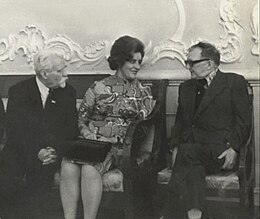| Symphony No. 15 | |
|---|---|
| by Dmitri Shostakovich | |
 Dmitri Shostakovich (far right) in 1974 (photograph by Yuri Shcherbinin) | |
| Key | A major |
| Opus | 141 |
| Composed | late 1970–July 29, 1971 |
| Published | 1972 |
| Publisher | Hans Sikorski Musikverlage |
| Duration | 45 minutes |
| Movements | 4 |
| Scoring | Orchestra |
| Premiere | |
| Date | January 8, 1972 |
| Location | Large Hall of the Moscow Conservatory |
| Conductor | Maxim Shostakovich |
| Performers | All-Union Radio and Television Symphony Orchestra |
The Symphony No. 15 in A major, Op. 141, composed between late 1970 and July 29, 1971, is the final symphony by Dmitri Shostakovich.[1] It was his first purely instrumental and non-programmatic symphony since the Tenth from 1953.[2][3][4][5] Shostakovich began to plan and sketch the Fifteenth in late 1970, with the intention of composing for himself a cheerful work to mark his 65th birthday the next year. After completing the sketch score in April 1971, he wrote the orchestral score in June while receiving medical treatment in the town of Kurgan. The symphony was completed the following month at his summer dacha in Repino.[6] This was followed by a prolonged period of creative inactivity which did not end until the composition of the Fourteenth Quartet in 1973.
The Fifteenth Symphony was first performed privately in a reduction for two pianos for members of the Union of Soviet Composers and invited guests in August 1971. Its scheduled world premiere in September was postponed when Shostakovich suffered his second heart attack earlier that month. Following a two-month hospitalization, Shostakovich recovered well enough to attend rehearsals for the Fifteenth's premiere starting in late December 1971. The premiere took place in Moscow on January 8, 1972, performed by the All-Union Radio and Television Symphony Orchestra conducted by Maxim Shostakovich. The Western hemisphere premiere took place in Philadelphia on September 28, 1972 with the Philadelphia Orchestra conducted by Eugene Ormandy. Immediate critical reaction to the symphony was overwhelmingly positive in the Soviet Union, but mixed in the West.
Shostakovich's extensive use of musical quotation in the Fifteenth has attracted speculation since its premiere. He initially likened the first movement to a "toyshop", but later cautioned listeners against taking his description too precisely. A quotation from Gioacchino Rossini's William Tell Overture recurs throughout the first movement, while the last movement quotes from a song by Mikhail Glinka and from Richard Wagner's Götterdämmerung and Tristan und Isolde. Critics have also detected in the symphony further quotations and allusions, from other composers as well as Shostakovich's own music. Bernard Jacobson wrote in 1972 that the symphony's lasting appeal was secured because it made use of "one of [Shostakovich's] greatest expressive assets—a teasing and often powerfully affective emotional ambivalence".[7]
- ^ Fairclough 2019, p. 153.
- ^ Prieto 2013, p. 241.
- ^ Fay 2000, p. 270.
- ^ Blokker & Dearling 1979, p. 150.
- ^ Ottaway 1978, p. 63.
- ^ Prieto 2013, p. 243.
- ^ Jacobson, Bernard (October 6, 1972). "Eugene Ormandy Leads Shostakovich Premiere". The Cincinnati Enquirer. Chicago Daily News. Archived from the original on December 27, 2021. Retrieved December 27, 2021.